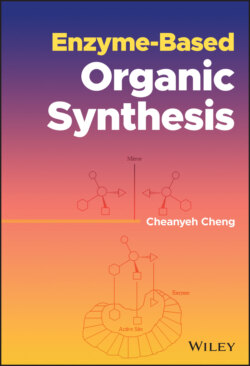Enzyme-Based Organic Synthesis

Реклама. ООО «ЛитРес», ИНН: 7719571260.
Оглавление
Cheanyeh Cheng. Enzyme-Based Organic Synthesis
Table of Contents
List of Tables
List of Illustrations
Guide
Pages
Enzyme‐Based Organic Synthesis
Preface
Acknowledgements
1 Introduction. 1.1 Discovery and Nature of Enzyme
1.2 Enzyme Structure and Catalytic Function. 1.2.1 Enzyme Structure
1.2.2 Catalytic Function
1.3 Cofactors and Coenzymes
1.4 Molecular Recognition and Enzyme Specificity
1.4.1 Substrate Specificity
1.4.2 Regiospecificity
1.4.3 Stereospecificity
1.5 Enzyme Classes and Nomenclature
1.6 Enzyme and Green Chemistry
1.7 The Winner of Year 2010: Greener Manufacturing of Sitagliptin Enabled by an Evolved Transaminase
1.8 The Winner of Year 2009: A Solvent‐Free Biocatalytic Process for Cosmetic and Personal Care Ingredients
References
2 Organic Synthesis with Oxidoreductases. 2.1 Oxidation Reactions
2.1.1 Oxidation of Alcohols and Aldehydes
2.1.2 Hydroxylation of Alkanes
2.1.3 Hydroxylation of Aromatic Compounds
2.1.4 Dihydroxylation of Aromatic Compounds
2.1.5 Epoxidation
2.1.6 Sulfoxidation Reactions
2.1.7 Baeyer–Villiger Reactions
2.1.8 Peroxidation Reactions
2.2 Reduction Reactions. 2.2.1 Reduction of Aldehydes and Ketones
2.2.2 Reduction of C═C Bonds
References
3 Organic Synthesis with Transferases. 3.1 Transamination with Aminotransferases
3.2 Glycosyl‐transfer with glycosyltransferase
3.3 Phosphorylation with Kinases
3.4 Acetyl Group Transfer with Acetyltransferase
References
4 Organic Synthesis with Hydrolases. 4.1 Hydrolysis of Ester Bond. 4.1.1 Ester Hydrolysis with Esterases
4.1.2 Ester Hydrolysis with Lipases
4.1.3 Ester Hydrolysis with Proteases
4.2 Hydrolysis of Amide Bond
4.3 Hydrolysis of Phosphate Esters
4.4 Hydrolysis of Epoxides
4.5 Hydrolysis of Hydantoins
4.6 Hydrolysis of Glycosidic Bonds and Natural Polysaccharide
4.6.1 Hydrolysis of Starch and Applications
4.6.2 Hydrolysis of Cellulose and Applications
4.6.3 Hydrolysis of Hemicellulose and Applications
References
5 Organic Synthesis with Lyases
5.1 Lyases with Carbon–Carbon Bonds. 5.1.1 Aldolases in Organic Syntheses
5.1.2 Enzymatic Acyloin Condensation
5.1.2.1 Acyloin Condensation Catalyzed by Pyruvate Decarboxylase
5.1.2.2 Acyloin Condensation Catalyzed by Benzoylformate Decarboxylase
5.1.2.3 Acyloin Condensation Catalyzed by Benzaldehyde Lyase
5.1.2.4 Acyloin Condensation Catalyzed by Phenylpyruvate Decarboxylase
5.1.3 Cyanohydrin Formation with Hydroxynitrile Lyases
5.2 Lyases with Carbon–Oxygen Bonds
5.2.1 Enzyme‐Catalyzed Water Addition to Electron‐Rich C=C Bonds
5.2.1.1 Oleate Hydratase
5.2.1.2 Linalool Dehydratase‐Isomerase
5.2.1.3 Limonene Hydratase
5.2.2 Enzyme‐Catalyzed Water Addition to Electron‐Deficient C=C Bonds. 5.2.2.1 Fumarase
5.2.2.2 Malease
5.2.2.3 Enoyl‐CoA Hydratase
5.3 Lyases with Carbon–Nitrogen Bonds
5.3.1 Aspartate Ammonia Lyase
5.3.2 Methylaspartate Ammonia Lyase
5.3.3 Aromatic Amino Acid Ammonia Lyases
5.3.3.1 l‐Arylalanines Synthesis
5.3.3.2 d‐Arylalanines Synthesis
5.3.3.3 β‐Arylalanines Synthesis
5.3.3.4 Applications for Arylalanines Synthesis
5.4 Lyases with Carbon–Sulfur Bonds
5.5 Lyases with Carbon–Halide Bonds
5.5.1 Synthesis of Chiral Epoxides
5.5.2 Synthesis of Enantiopure β‐Substituted Alcohols
5.5.3 Application of Cascade Reactions
References
6 Organic Synthesis with Isomerases
6.1 Racemases and Epimerases. 6.1.1 Amino Acid Racemases and Epimerases
6.1.1.1 D‐Amino Acid Synthesis with PLP‐Dependent Amino Acid Racemases
6.1.1.2 D‐Amino Acid Synthesis with PLP‐Independent Amino Acid Racemases
6.1.1.3 Amino Acid Racemases with Broad Substrate Specificity
6.1.1.4 Applications of Amino Acid Racemases and Epimerases
6.1.2 Hydroxy Acid Racemases and Epimerases. 6.1.2.1 Lactate Racemase
6.1.2.2 Mandelate Racemase
6.1.3 N‐Acetyl‐D‐glucosamine 2‐ epimerase
6.1.4 Hydantoin Racemase
6.2 Cis‐Trans Isomerase. 6.2.1 Maleate Cis‐Trans Isomerase
6.2.2 Linoleate Isomerase
6.3 Intramolecular Oxidoreductases. 6.3.1 Aldose‐Ketose isomerases. 6.3.1.1 Xylose (Glucose) Isomerase
6.3.1.2 L‐Rhamnose Isomerase
6.3.1.3 L‐Fucose Isomerase
6.4 Intramolecular Transferases. 6.4.1 Phosphopentomutase
6.4.2 Lysine 2,3‐Aminomutase
6.4.3 Lysine 5,6‐Aminomutase
6.4.4 Tyrosine 2,3‐Aminomutase
6.4.5 Phenylalanine Aminomutase. 6.4.5.1 L‐β‐Phenylalanine Forming
6.4.5.2 D‐β‐Phenylalanine Forming
6.5 Intramolecular Lyases. 6.5.1 ent‐Copalyl Diphosphate Synthase
6.5.2 Lycopene β‐Cyclase
References
7 Organic Synthesis with Ligases
7.1 Ligases for Carbon–Oxygen Bonds Formation. 7.1.1 Olefin β‐Lactone Synthetase
7.2 Ligases for Carbon–Sulfur Bonds Formation. 7.2.1 Acetate‐CoA Ligase (AMP‐forming)
7.2.2 Medium‐chain Acyl‐CoA Ligase
7.2.3 Long‐chain‐fatty‐acid‐CoA Ligase
7.3 Ligases for Carbon–Nitrogen Bonds Formation. 7.3.1 Glutamine Synthetase
7.3.2 L‐Alanine‐L‐anticapsin Ligase
7.3.3 Carbapenam‐3‐carboxylate Synthase
7.4 Ligases for Carbon–Carbon Bonds Formation. 7.4.1 Pyruvate Carboxylase
7.4.2 Acetyl‐CoA Carboxylase
References
8 Future Perspectives. 8.1 Combinatorial Enzymatic Organic Synthesis. 8.1.1 Combinatorial Chemistry
8.1.2 Principle of Combinatorial Chemistry
8.1.3 Combinatorial Chemistry with Enzymes
8.1.3.1 Enzymes as a Tool in Combinatorial Synthesis
8.1.3.2 Combinatorial Biocatalysis
8.1.3.3 Combinatorial Biosynthesis
8.2 Artificial Intelligence Assisted Enzymatic Organic Synthesis. 8.2.1 Introduction to Artificial Intelligence
8.2.2 Categorization of Artificial Intelligence
8.2.3 Machine Learning
8.2.4 Artificial Intelligence with Enzymatic Organic Synthesis
References
Index. a
b
c
d
e
f
g
h
i
j
k
l
m
n
o
p
q
r
s
t
u
v
w
x
y
z
WILEY END USER LICENSE AGREEMENT
Отрывок из книги
Cheanyeh Cheng
.....
To encourage and propel the implementation of green chemistry, the Presidential Green Chemistry Challenge Award was established by the United States government in 1996. The following are several award winners that can be used as models in green chemistry by using enzyme and related microbe for production of chemicals [35].
The winner of year 2011: Production of Basic Chemicals from Renewable Feedstocks at Lower Cost
.....